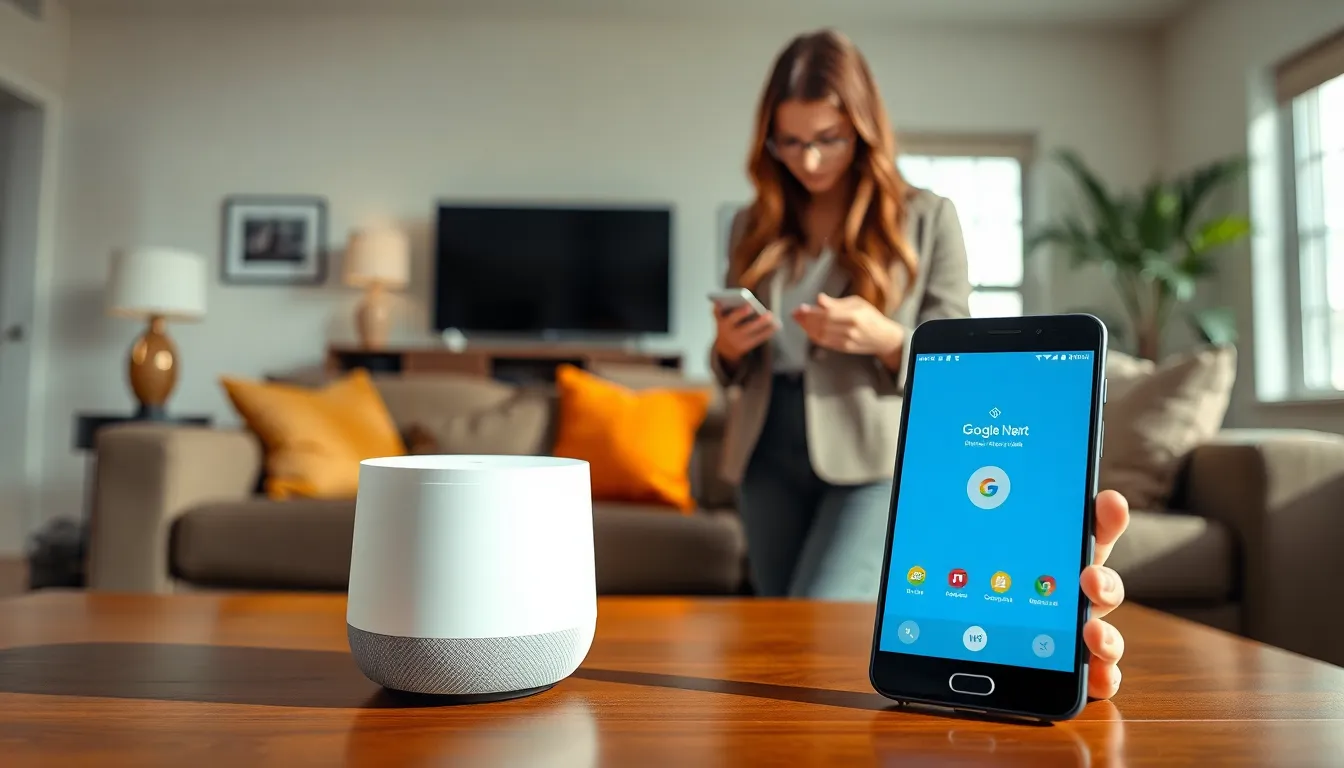Table of Contents
ToggleSetting up a Google Nest device can transform any home into a smart haven. With its powerful features and seamless integration, it’s no wonder that many are eager to get started. However, connecting Google Nest to Wi-Fi can sometimes feel daunting, especially for those new to smart technology.
In this guide, readers will discover straightforward steps to establish a reliable Wi-Fi connection for their Google Nest devices. Whether it’s the Nest Hub, Nest Mini, or another model, getting connected is essential for unlocking the full potential of these innovative gadgets. With a little guidance, anyone can enjoy the convenience of a smart home.
Understanding Google Nest
Google Nest comprises a range of smart home devices designed to integrate seamlessly into daily living. These devices enhance home automation, security, and convenience through voice control and connectivity.
Overview of Google Nest Devices
Google Nest devices include various smart technologies, such as:
- Nest Hub: A smart display that provides visual updates, controls, and voice commands.
- Nest Mini: A compact smart speaker for audio playback and voice assistant functionality.
- Nest Thermostat: A smart thermostat that optimizes temperature control and energy savings.
- Nest Doorbell: A video doorbell that offers remote monitoring and alerts for visitors.
- Nest Cam: A security camera system that provides real-time footage and alerts.
These devices work collectively to increase efficiency and simplify daily tasks around the home.
Importance of WiFi Connection
A reliable Wi-Fi connection underpins the functionality of Google Nest devices. Connecting to Wi-Fi allows:
- Real-time communication: Devices stay updated with the latest features and improvements.
- Remote access: Users can control devices from anywhere, enhancing security and convenience.
- Integration: Multiple devices operate together, creating a cohesive smart home experience.
Without a stable Wi-Fi connection, the full potential of Google Nest devices remains limited.
Preparing for the Connection

Preparing the Google Nest for a Wi-Fi connection involves a few straightforward steps. This preparation ensures a seamless setup process for optimal performance.
Checking Your WiFi Network
Check the Wi-Fi network’s stability and performance, ensuring a robust signal. Ensure the router operates on either the 2.4 GHz or 5 GHz frequency bands, as Google Nest devices support both. Use a device, such as a smartphone or laptop, to verify the network connection. Position the router within 30 feet of the Google Nest for optimal connectivity. Confirm that the network is functional by testing internet access on another connected device.
Gathering Necessary Information
Gather key information prior to connecting the Google Nest device. Note the Wi-Fi network name (SSID) and password, as this information is required during setup. Ensure that the password is accurate and contains no typos. Familiarize yourself with the Google Home app, which assists with device setup and management. Make certain that the mobile device, used for setup, is on the same Wi-Fi network designated for the Google Nest device.
Step-by-Step Guide to Connect Google Nest to WiFi
Connecting a Google Nest device to Wi-Fi involves a few straightforward steps, ensuring optimal performance from the smart technology. Follow this guide to navigate the setup process efficiently.
Using the Google Home App
- Download the App: Obtain the Google Home app from the Apple App Store or Google Play Store.
- Launch the App: Open the Google Home app on the mobile device connected to the Wi-Fi network.
- Add Device: Tap the ‘+’ icon, select ‘Set up device,’ then choose ‘New devices’ for Google Nest setup.
- Select Location: Choose a home location where the device will be placed.
- Connect to Wi-Fi: The app scans for available devices. Select your Google Nest device, follow prompts, and enter the Wi-Fi network’s SSID and password.
- Finalize Setup: Follow the remaining instructions to finish the installation, including assigning the device to rooms and naming it for easy control.
Manual Connection Process
- Prepare Device: Ensure the Google Nest device is plugged in and turned on.
- Activate Setup Mode: Press and hold the setup button on the device until it announces readiness for pairing.
- Connect via Device Settings: Open the Wi-Fi settings on the mobile device. Locate the Google Nest device’s temporary hotspot (it typically appears as “Google Nest”).
- Enter Network Details: Once connected to the device’s hotspot, navigate to the Google Home app and input the desired Wi-Fi network name (SSID) and password.
- Confirm Connection: The app will confirm if the connection is successful. If prompted, return to your original Wi-Fi network.
- Complete Setup: Follow any remaining on-screen instructions to configure the device settings and preferences.
Troubleshooting Connection Issues
Connection issues may arise during the setup or operation of Google Nest devices. Identifying common problems and implementing solutions can restore functionality.
Common Problems and Solutions
- Weak Wi-Fi Signal: If the Google Nest device fails to connect, ensure the router is within 30 feet of the device. Moving the router closer or eliminating obstacles can enhance the signal.
- Incorrect Wi-Fi Credentials: Verify the Wi-Fi network name (SSID) and password. Even minor typographical errors can prevent connection.
- Outdated Google Home App: An outdated app can lead to compatibility issues. Check for updates in the app store and install the latest version.
- Overloaded Network: Too many devices connected to the network can cause congestion. Disconnecting idle devices may improve performance.
- Router Issues: Restarting the router can resolve temporary connectivity problems. Unplug the device for 10 seconds before reconnecting.
- Device Not in Setup Mode: Ensure the Google Nest device is in setup mode (usually indicated by a blinking light). If necessary, reset the device by holding the appropriate button for 10 seconds.
- System Interference: Electronics like microwaves or cordless phones can interfere with Wi-Fi signals. Repositioning these devices may enhance connectivity.
When to Seek Additional Help
- Google Nest Support: Visit the official Google Nest support page for device-specific troubleshooting guides and customer service.
- Internet Service Provider: If issues appear network-related, contacting the internet service provider can identify connectivity problems on their end.
- Product Warranty: For hardware issues, check the warranty status. Authorized service centers can provide repairs or replacements if necessary.
Connecting Google Nest devices to Wi-Fi is a crucial step in creating a smart home environment. With the right setup users can unlock the full potential of their devices enhancing convenience security and automation. By following the outlined steps and troubleshooting tips anyone can navigate the process smoothly.
A strong and stable Wi-Fi connection ensures seamless operation allowing users to control their devices remotely and enjoy real-time updates. Embracing smart technology not only simplifies daily tasks but also transforms homes into efficient living spaces. As users become more familiar with their Google Nest devices they’ll discover endless possibilities for home automation and connectivity.









